In the ever-evolving world of interior design, few aesthetic choices stand the test of time quite like the black and white kitchen. This classic pairing transcents fleeting trends, offering a canvas thats both boldly dramatic and endlessly adaptable.
Whether you’re planning a complete renovation or simply refreshing your current space, embracing the timeless contrast of black and white provides a foundation that can evolve with your taste while maintaining its sophisticated appeal.
According to a 2024 survey by Kitchen & Bath Design News, 68% of designers reported an increase in requests for black and white kitchen schemes over the past three years, confirming that this classic combination isn’t just surviving—it’s thriving in contemporary homes.
This comprehensive guide will walk you through everything you need to know about creating a stunning black and white kitchen that balances visual impact with practical functionality, all while reflecting your unique style and needs.
The Psychology of Black and White in Kitchen Design
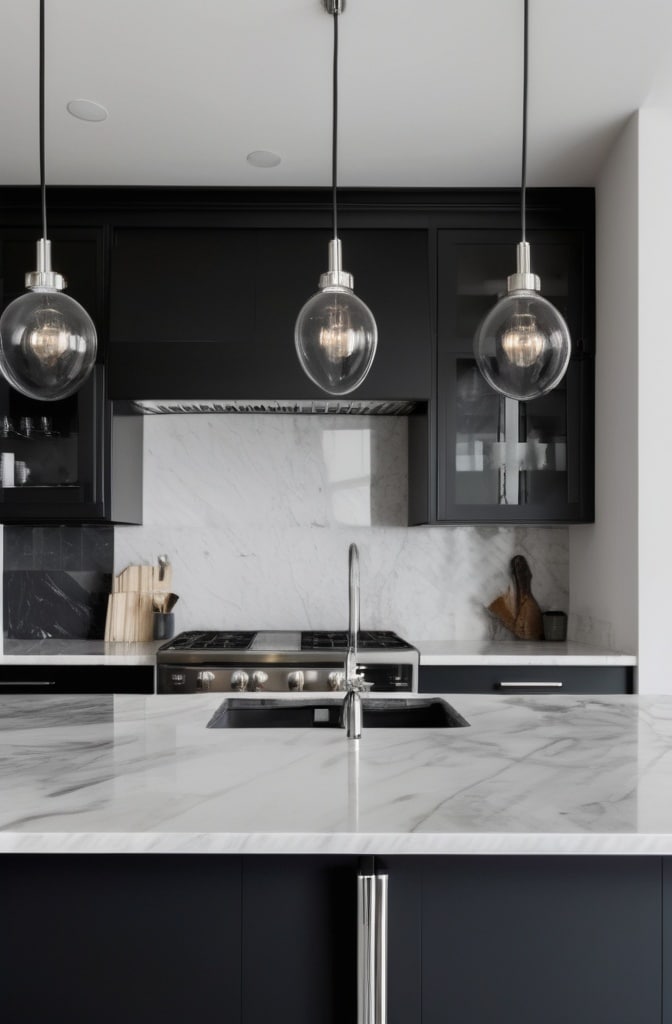
Before diving into specific design elements, understanding how these contrasting colors affect our perception and emotional response can help inform your choices. Black and white isn’t just a stylistic decision—it’s a psychological one.
White spaces are widely known to create feelings of cleanliness, openness, and calm. Design psychologist Dr. Sally Augustin explains, “White surfaces reflect more light, creating an expanded feeling of space that can make even smaller kitchens feel more generous.” This reflective quality makes white an excellent choice for base elements in kitchens with limited natural light.
In contrast, black anchors a space with sophistication and definition. “Black elements create visual weight and draw the eye,” notes interior designer Marcus Wells. “Used strategically, black provides resting points that can actually make a space feel more organized and intentional.”
The combination of these opposing forces creates what designers call “dynamic tension”—a visual interest that keeps the eye moving through the space rather than settling in one area. This movement creates a sense of energy that suits the kitchen’s role as an active working space.
The 70/30 Rule for Perfect Balance
Professional kitchen designers often recommend following the 70/30 principle when working with black and white—dedicating approximately 70% to one color and 30% to the other. This creates visual hierarchy while preventing either shade from overwhelming the space.
For most spaces, especially smaller kitchens or those with limited natural light, white works best as the dominant color (70%), with black as the accent (30%). However, in larger, well-lit spaces, this can be reversed for a more dramatic statement.
Finding Your Perfect Balance
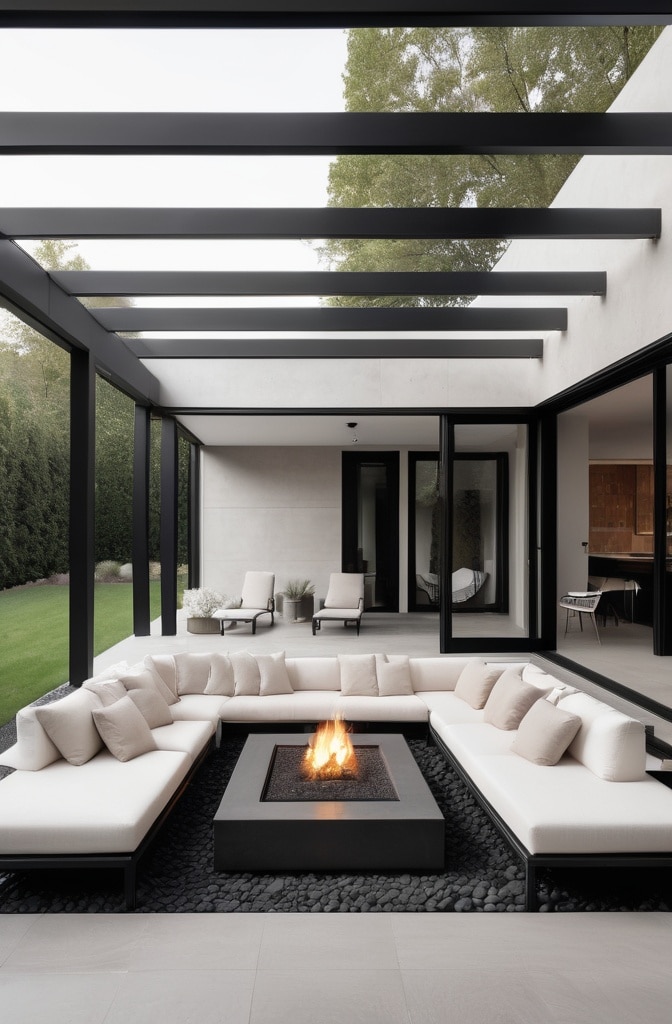
The ideal black and white ratio depends on several factors unique to your space and preferences:
Assessing Your Natural Light
Before finalizing any design decisions, spend time observing how natural light interacts with your kitchen throughout the day. South and west-facing kitchens typically receive more warm, direct sunlight, which can balance the coolness of a predominantly white space. North-facing kitchens receive cooler, indirect light, which might benefit from warmer elements to prevent the space from feeling too stark.
“I always recommend my clients live with paint samples on their walls for at least three days before committing,” says lighting designer Jennifer Kou. “The way light changes throughout the day dramatically affects how we perceive both black and white elements.”
For kitchens with minimal natural light, increasing the white ratio helps maximize brightness, while strategic black accents provide definition without absorbing too much of the limited available light.
Space Perception Considerations
Black and white each affect our perception of space dimensions:
- White visually expands – Using white on walls, ceilings, and larger cabinet surfaces creates an illusion of more space
- Black visually contracts – Black elements appear to advance toward the viewer, making them ideal for creating focal points
- Horizontal black lines – Can make a space feel wider
- Vertical black elements – Can enhance ceiling height
Interior architect Paul Rodriguez explains, “A common mistake is applying dark colors in an already small space. Instead, use black strategically on lower cabinetry to ground the space while keeping eye-level elements lighter.”
Cabinet Configurations That Work
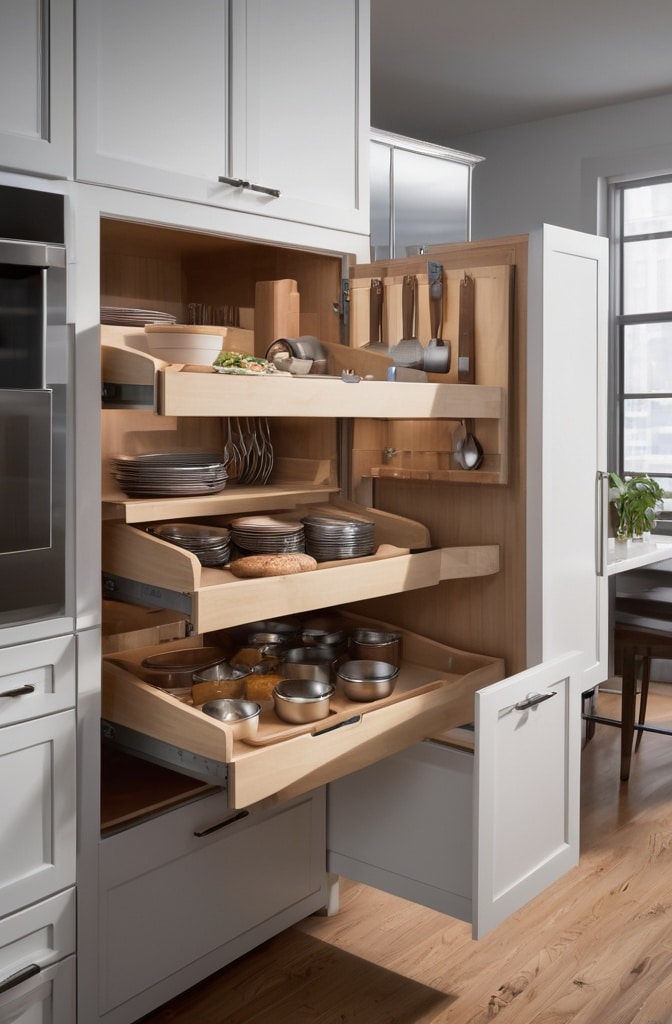
Cabinets typically constitute the largest visual element in your kitchen, making them perhaps the most important decision in your black and white design scheme.
White Cabinets with Black Hardware: The Classic Approach
This timeless combination offers tremendous versatility, providing a neutral backdrop that ages well both aesthetically and functionally. White cabinets reflect light and expand the perceived space, while black hardware adds definition without overwhelming.
Kitchen designer Teresa Mattingly notes, “White cabinetry provides a clean canvas that can evolve with changing taste. When clients are uncertain about committing to stronger design elements, I often recommend white cabinets with matte black hardware as a foundation that can support various accessory colors down the road.”
For a subtle variation that adds visual interest, consider different white tones rather than a stark bright white. Warmer whites like ivory or cream can soften the contrast, while cooler whites with blue or gray undertones create a more contemporary feel.
Bold Black Cabinets with White Countertops: Making a Statement
For those willing to embrace a more dramatic look, black cabinets paired with white countertops create striking contrast. This arrangement works particularly well in larger kitchens with abundant natural light, where black cabinetry serves as an elegant anchor rather than a space-diminishing element.
“Black cabinetry is experiencing a renaissance,” observes trend forecaster Michael Porter. “We’ve seen a 43% increase in black cabinet installations since 2022, particularly in higher-end renovations where homeowners are seeking distinctive designs with staying power.”
To prevent the space from feeling too dark:
- Opt for white or light-colored walls to balance dark cabinetry
- Include adequate task lighting under cabinets and over work surfaces
- Consider glass-front sections on some upper cabinets to break up large expanses of black
Two-Tone Cabinet Arrangements: Best Practices
The two-tone approach—typically with white upper cabinets and black lower cabinets—has become increasingly popular for good reason. This configuration takes advantage of each color’s strengths: white uppers keep the eye-level space feeling open and bright, while black base cabinets ground the room and hide the inevitable scuffs and marks that occur in high-traffic areas.
According to kitchen industry statistics, two-tone cabinetry installations increased by 58% between 2020 and 2023, with black and white being the most requested combination.
Real-world example: Homeowner Sarah McKenzie incorporated this approach in her 2023 kitchen renovation. “The white uppers make our modest kitchen feel spacious, while the black lowers add sophistication. The bonus is that the lower cabinets hide the evidence of our three kids and dog!”
Read This Blog: https://hometranquil.com/living-room-ideas-for-modern/
Countertop Material Guide for Black and White Kitchens

Countertops provide both functional surfaces and visual continuity in your black and white design. The material you select can either reinforce the monochromatic theme or introduce subtle texture and variation.
Marble Options: From Carrara to Nero Marquina
Marble naturally incorporates both black and white in its veining patterns, making it an intuitive choice for monochromatic kitchens. Popular varieties include:
- Carrara: Light gray background with subtle, feathery veining
- Calacatta: Whiter background with more dramatic, wider veining
- Nero Marquina: Deep black with crisp white veining
While undeniably beautiful, true marble requires particular care. “Marble is porous and can stain when exposed to acidic substances like lemon juice or red wine,” warns materials specialist Elena Carvajal. “For clients who entertain frequently or have young families, I often suggest more forgiving alternatives that mimic marble’s aesthetic.”
Engineered Quartz Alternatives
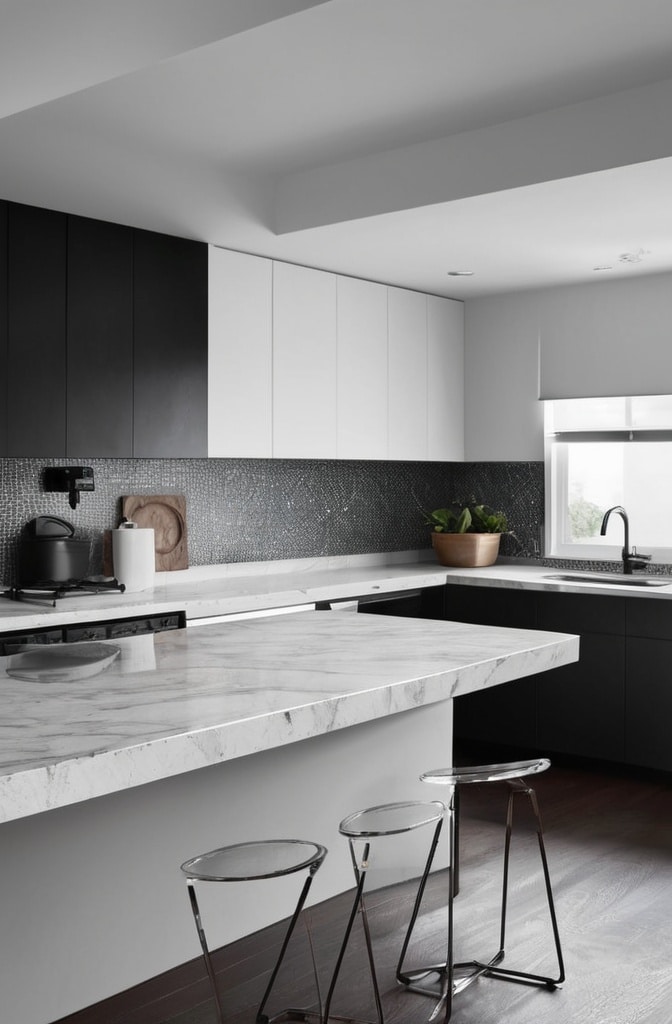
For practical luxury in black and white kitchens, engineered quartz has become the go-to choice. Manufacturers like Caesarstone, Silestone, and Cambria offer numerous options that mimic natural stone while providing superior durability and minimal maintenance.
A 2023 National Kitchen and Bath Association report revealed that engineered quartz surpassed granite as the most popular countertop material, with 64% of new kitchen installations featuring this versatile surface.
Cost comparison across common countertop materials:
MaterialAverage Cost Per Square Foot (Installed)Durability RatingMaintenance LevelEngineered Quartz$75-$120Very HighLowGranite$60-$100HighMediumMarble$75-$250MediumHighButcher Block$40-$100MediumMedium-HighSolid Surface$35-$85Medium-HighLow
Butcher Block and Wood Elements for Warmth
Wood countertops introduce essential warmth to black and white kitchens, preventing the space from feeling too clinical or stark. In fully monochromatic designs, wooden elements provide what designers call “visual relief”—a break from high contrast that gives the eye a place to rest.
“I often incorporate a butcher block island or section of countertop in black and white kitchens,” shares kitchen designer Rafael Novak. “The natural material adds texture and warmth that softens the graphic quality of black and white, making the space feel more welcoming.”
Flooring That Grounds Your Design
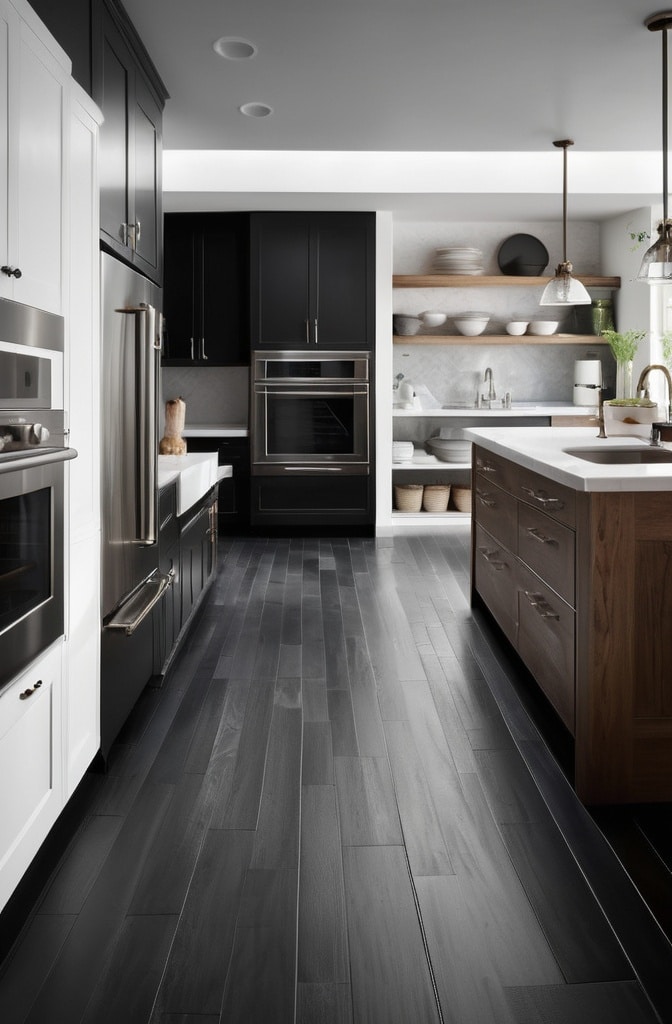
Flooring quite literally forms the foundation of your kitchen design, and in black and white kitchens, it presents an opportunity to either reinforce the monochromatic theme or introduce complementary elements.
Beyond Checkered: Modern Interpretations of Classic Patterns
The classic black and white checkered floor has evolved far beyond traditional 12″×12″ tiles. Contemporary interpretations include:
- Oversized checks (24″×24″ or larger)
- Harlequin patterns (diamonds rather than squares)
- Fragmented checkerboards with irregular transitions
- Pixelated patterns that gradually shift from light to dark
Flooring specialist Devon Richards explains, “The beauty of modern interpretations is that they reference the classic look while feeling fresh and intentional rather than simply nostalgic.”
Practical Durability Considerations
Kitchen flooring must withstand heavy traffic, possible water exposure, and the occasional dropped pot. When selecting black and white flooring, balance aesthetic appeal with practical performance:
- Porcelain tile: Offers excellent durability with virtually unlimited design options, including convincing wood and stone looks in black and white colorways
- Luxury vinyl tile (LVT): Provides comfort underfoot and water resistance with increasingly sophisticated black and white patterns
- Engineered hardwood: Can be stained for custom black/white/gray tones while offering better moisture resistance than solid wood
“The kitchen floor takes more abuse than any other surface in the home,” notes contractor Maria Lewis. “Investing in quality material here pays dividends, as replacement is disruptive and costly.”
For households with children or seniors, consider slip resistance ratings when selecting flooring. Many glossy black tiles can become hazardous when wet—opt for textured finishes or smaller tiles with more grout lines for better traction.
Backsplash as Personality Statement
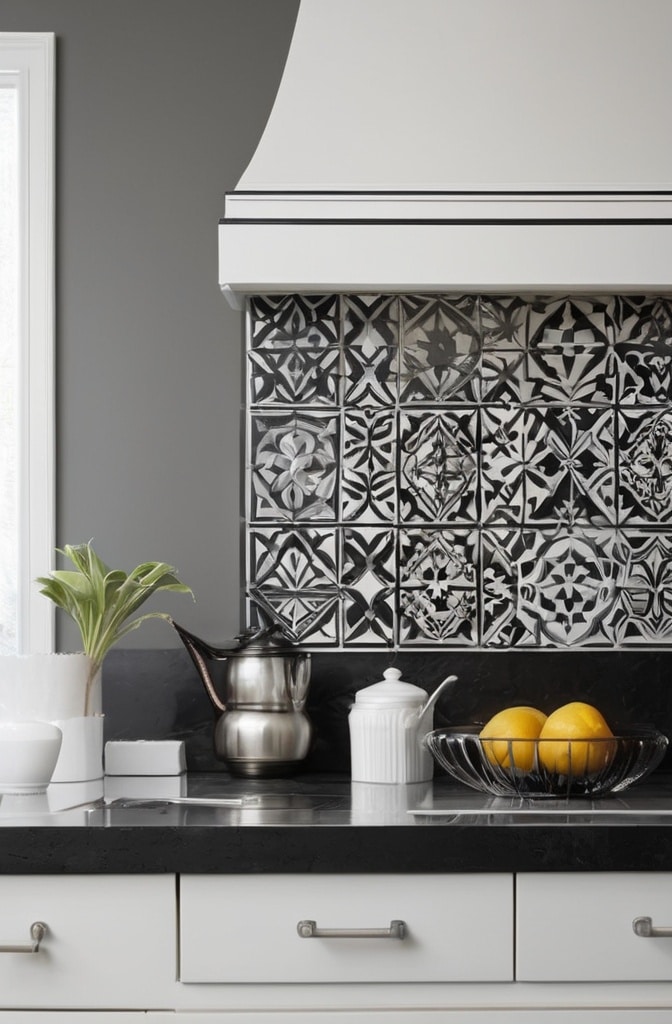
In black and white kitchens, the backsplash offers perfect opportunity to inject personality while reinforcing the color scheme. This relatively small area can make a disproportionately large visual impact.
Subway Tile Reinvented
While white 3″×6″ subway tiles remain popular for their timeless appeal, contemporary interpretations offer fresh takes on this classic:
- Stacked vertically instead of traditional running bond pattern
- Larger formats (4″×12″ or 4″×16″)
- Beveled edges that catch light and add dimension
- Contrasting dark grout with white tiles for graphic definition
Designer Thomas Chen observes, “Black grout with white subway tiles has become something of a modern classic in its own right. It references traditional subway installations while clearly belonging to our era.”
Geometric Patterns That Enhance Spatial Perception
Geometric backsplash patterns can visually alter your kitchen’s proportions:
- Horizontal patterns make walls appear wider
- Vertical patterns heighten the space
- Herringbone at 45° leads the eye diagonally, creating energy and movement
- Hexagons and arabesques add curved elements that soften the inherant angularity of black and white
“I recently completed a narrow galley kitchen where we used elongated white hexagon tiles with black grout running horizontally,” shares designer Monique Wilson. “The pattern visually pushed the walls apart, making the space feel significantly more generous.”
For budget-conscious renovations, peel-and-stick backsplash options have improved dramatically in recent years. Brands like Tempaper and WallPops offer sophisticated black and white patterns that can be installed as weekend DIY projects without special tools or professional installation.
Lighting Strategies for Monochrome Spaces
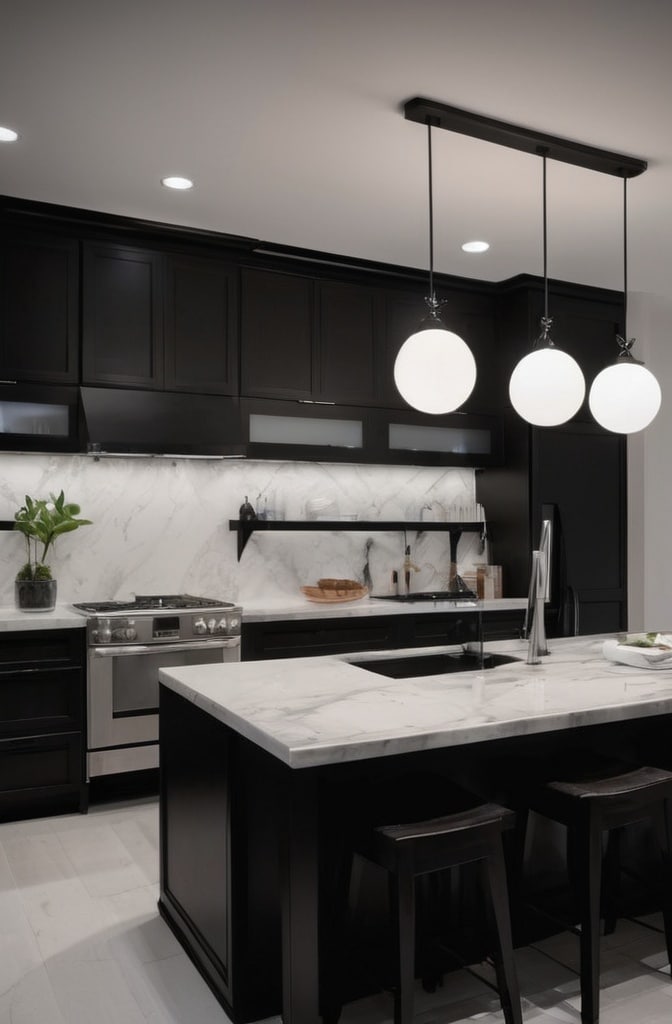
Lighting plays a critical role in how we perceive black and white, dramatically affecting the mood and functionality of monochromatic kitchens.
Layered Lighting Concepts
Professional kitchen designs incorporate three distinct lighting layers:
- Ambient lighting: Provides overall illumination, typically via recessed ceiling fixtures, pendant lights, or flush mounts
- Task lighting: Illuminates work areas through under-cabinet lights, pendant lights over islands, or focused recessed lights
- Accent lighting: Highlights architectural features or display areas using strip lights, in-cabinet lighting, or directional spotlights
“In black and white kitchens, improper lighting can reduce contrast and flatten the design,” warns lighting designer Kendra Williams. “I recommend dimmer switches on all circuits to adjust lighting levels throughout the day and for different activities.”
Color Temperature Considerations
The color temperature of your lighting significantly impacts how black and white elements appear:
- Warm light (2700-3000K): Creates a cozy atmosphere but may give white surfaces a yellowish tint
- Neutral light (3500-4000K): Provides balanced illumination that renders both black and white accurately
- Cool light (5000K+): Creates a crisp, energetic feel but can make spaces feel institutional if overused
Most designers recommend neutral to slightly warm lighting (around 3000-3500K) for black and white kitchens, creating a balance between accuracy and comfort.
For maximum flexibility, consider smart lighting systems that allow you to adjust both brightness and color temperature. These systems have become more affordable in recent years, with entry-level options starting around $200 for basic kitchen coverage.
Design Style Adaptations
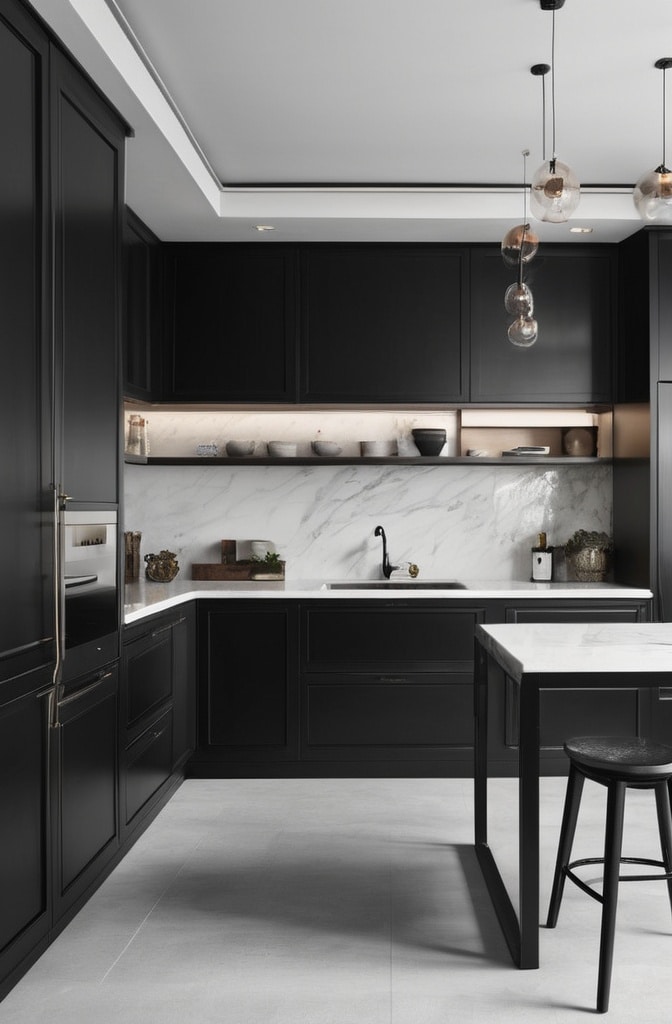
The beauty of black and white lies in its versatility across different design aesthetics. Here’s how this color scheme adapts to popular styles:
Modern Minimalist: Clean Lines and Intentional Simplicity
In minimalist applications, black and white creates a gallery-like backdrop where each element stands out with purpose:
- Handleless cabinetry with push-open mechanisms
- Integrated appliances that disappear into the design
- Hidden storage that maintains clean lines
- Limited accessories, each carefully chosen for form and function
“Minimalism isn’t about absence—it’s about intention,” explains design theorist James Paulson. “A well-executed minimalist black and white kitchen feels serene rather than empty, with every element serving both practical and aesthetic purposes.”
Farmhouse Interpretation: Rustic Elements Meet Classic Contrast
The modern farmhouse style softens black and white with textural elements and vintage touches:
- Shaker-style white cabinets with black hardware
- Apron-front (farmhouse) sinks in white fireclay or black soapstone
- Open shelving displaying curated collections
- Mixed metals with aged or matte finishes
- Natural wood accents that add warmth and history
According to Pinterest trend reports, farmhouse-style black and white kitchens consistently rank among the most-saved kitchen images, with particular interest in two-tone cabinet arrangements that pair white uppers with black lowers.
Industrial Edge: Raw Materials in Monochrome Context
Industrial-inspired black and white kitchens embrace the inherant character of utilitarian materials:
- Concrete countertops in light gray to near-black tones
- Exposed black steel shelving or range hoods
- Subway tile with dark grout for a factory-inspired look
- Matte black fixtures and hardware with substantial weight
- Vintage-inspired black pendant lights with metal shades
“Industrial black and white differs from other interpretations through embracing imperfection,” notes designer Rebecca Torres. “Slight variations in concrete, patina on metals, and visible welds all contribute to the authentic character.”
Scandinavian Balance: Light-Focused with Thoughtful Dark Accents
Scandinavian-inspired kitchens prioritize light maximization while incorporating black as a grounding element:
- Predominantly white spaces with abundant natural materials
- Black hardware and lighting fixtures as precise accents
- Pale woods (ash, birch, white oak) to add warmth without color
- Minimal upper cabinetry, often replaced with open shelving
- Strategic black details that create visual rhythm
“Scandinavian design is fundamentally practical, responding to northern regions with limited daylight,” explains Nordic design specialist Eva Hansson. “The careful balance of black accents in predominantly white spaces creates visual interest without absorbing precious light.”
Texture as the Essential Third Dimension
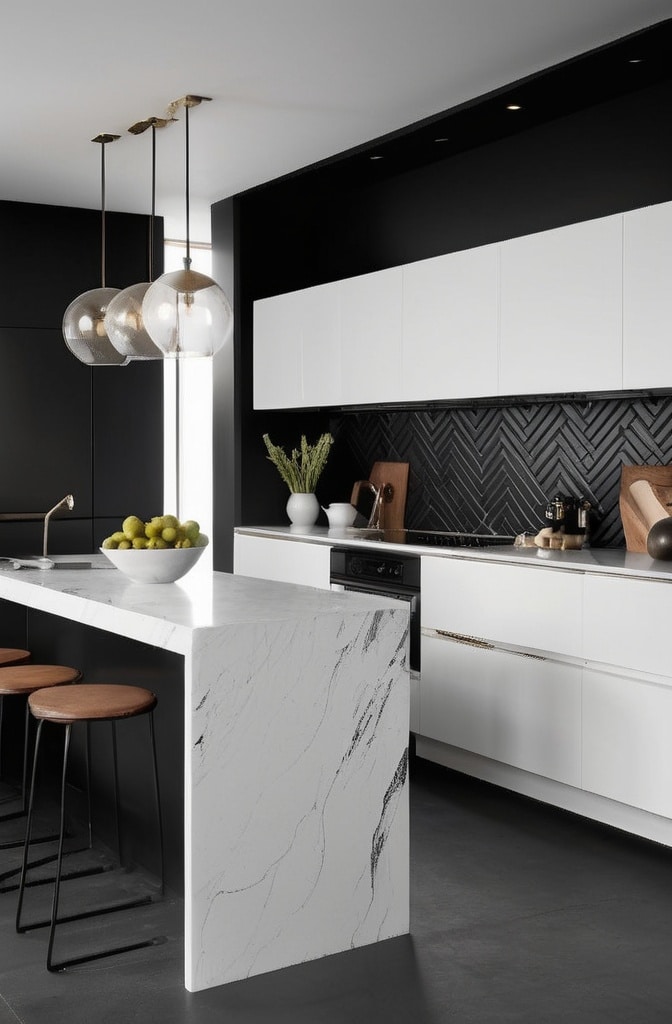
In monochromatic designs, texture becomes crucial for creating visual depth and interest without introducing additional colors.
Material Mixing Guide
Professional designers recommend incorporating 3-5 distinct textures in black and white kitchens to prevent the space from feeling flat. Successful combinations might include:
- High-gloss cabinet fronts
- Matte countertops
- Textured tile backsplash
- Woven natural fiber rug or window treatments
- Smooth metal fixtures and hardware
“The sophistication of a black and white kitchen often lies in its textural complexity rather than its color scheme,” observes materials specialist Jason Kim. “Without adequate texture, these spaces risk feeling like generic showrooms rather than lived-in homes.”
Gloss vs. Matte: Strategic Placement
The contrast between glossy and matte finishes adds subtle depth to monochromatic spaces:
- High-gloss surfaces reflect light and create visual movement, making them ideal for smaller spaces that benefit from light reflection. However, they show fingerprints and smudges more readily.
- Matte finishes absorb light and create a soft, sophisticated appearance with better fingerprint resistance, though they may make spaces feel slightly darker.
Designer Samantha Ellis recommends, “Consider how each surface will be used when deciding between gloss and matte. High-touch areas like cabinet doors around the refrigerator or sink might be better suited to fingerprint-resistant matte finishes, while cabinet fronts in less frequently accessed areas can showcase dramatic high-gloss black.”
Many contemporary kitchens mix finish types strategically—perhaps matte black lower cabinets with glossy white uppers—to create subtle visual hierarchy within the monochromatic palette.
Accents and Accessories That Pop

While commitment to black and white creates a cohesive foundation, thoughtfully chosen accents prevent the space from feeling too austere or impersonal.
Strategic Color Introduction
When introducing accent colors to black and white kitchens, designers suggest following the 80/15/5 rule:
- 80% black and white base elements
- 15% metallic or wood tones
- 5% true accent color
Popular accent colors for black and white kitchens include:
- Emerald green: Adds luxury and organic connection
- Cobalt blue: Creates sophistication and visual depth
- Warm red or terracotta: Introduces energy and warmth
- Yellow: Brings sunshine and optimism
“A little color goes a very long way in a black and white space,” advises color consultant Rebecca Chen. “What might seem like a modest pop of color in another design scheme becomes dramatically impactful against a monochromatic backdrop.”
For commitment-phobes, incorporate color through easily changeable elements like:
- Dish towels and oven mitts
- Countertop appliances (mixer, toaster, coffee maker)
- Fruit bowls or vases
- Removable wallpaper inside glass-front cabinets
Metallics as Neutral Accents
Metallic finishes function as “colored neutrals” in black and white kitchens, adding dimension without disrupting the monochromatic scheme:
- Brass and gold tones: Add warmth and sophistication
- Chrome and silver: Create cool, clean modernity
- Copper and bronze: Introduce warmth with vintage appeal
- Matte black metal: Reinforces the black elements while adding textural contrast
“The hardware and fixtures are the jewelry of the kitchen,” says designer Olivia Grant. “In black and white spaces, metallics provide welcome reflection and catch the eye as it moves through the space.”
Industry reports indicate that mixed metal kitchens have gained significant popularity, with 72% of designers incorporating at least two metal finishes in their projects, up from 47% in 2020.
Small Space Solutions
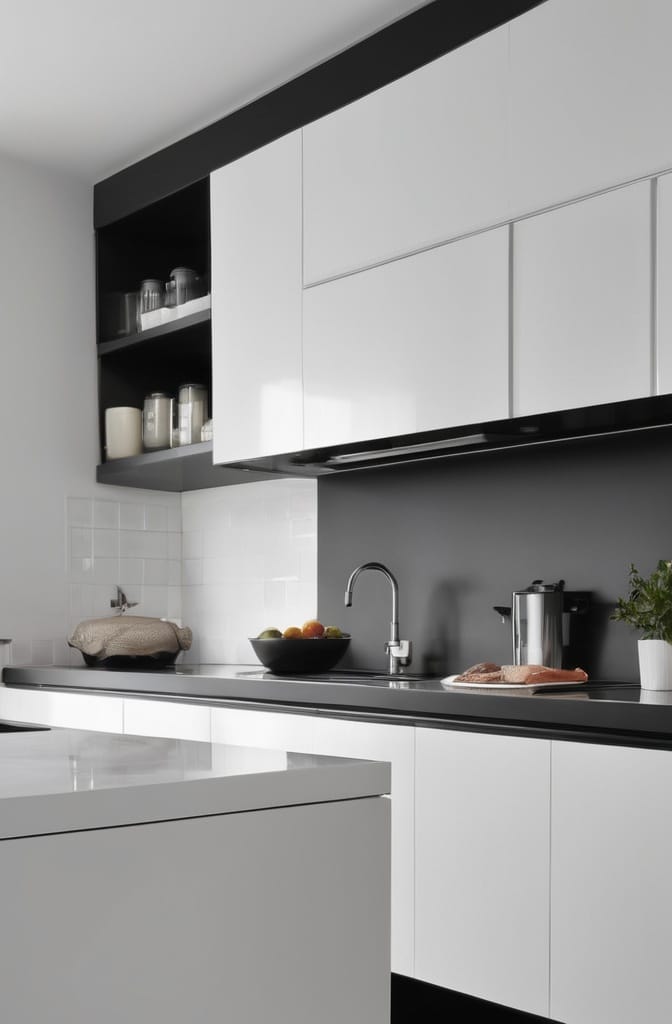
Black and white can be particularly effective in compact kitchens when applied with careful consideration of visual weight and light reflection.
Visual Tricks That Expand Perceived Space
Designers use several optical illusions to make small black and white kitchens feel more spacious:
- Continuous flooring: Extending the same flooring from adjacent rooms into the kitchen removes visual boundaries
- Reflective surfaces: Glossy cabinet fronts, mirrored backsplashes, and polished countertops bounce light and create depth
- Cabinet color placement: White upper cabinets with black lower cabinets draw the eye upward, enhancing height perception
- Vertical elements: Tall pantry cabinets or vertical backsplash patterns emphasize ceiling height
“In spaces under 150 square feet, I typically recommend a ratio of at least 60% white to 40% black,” advises small-space specialist Marina Torres. “This ensures the space feels open while still benefiting from the sophisticated contrast.”
Storage Innovations That Maintain Clean Aesthetics
Small black and white kitchens benefit from specialized storage solutions that maximize function while minimizing visual clutter:
- Pull-out pantry systems that utilize narrow vertical spaces
- Deep drawer organizers instead of awkward base cabinets
- Vertical dividers for baking sheets and cutting boards
- Cabinet door organizers for spices and small items
- Appliance garages that keep countertops clear
Real-world example: Homeowner David Chen transformed his 95-square-foot kitchen using black lower cabinets, white upper cabinets, and an ingenious storage system. “Every inch serves multiple purposes,” he explains. “My knife block pulls out from a 4-inch space between cabinets, and what looks like a decorative panel below the sink actually tilts out to store sponges and brushes.”
Maintenance Realities of Black and White Kitchens
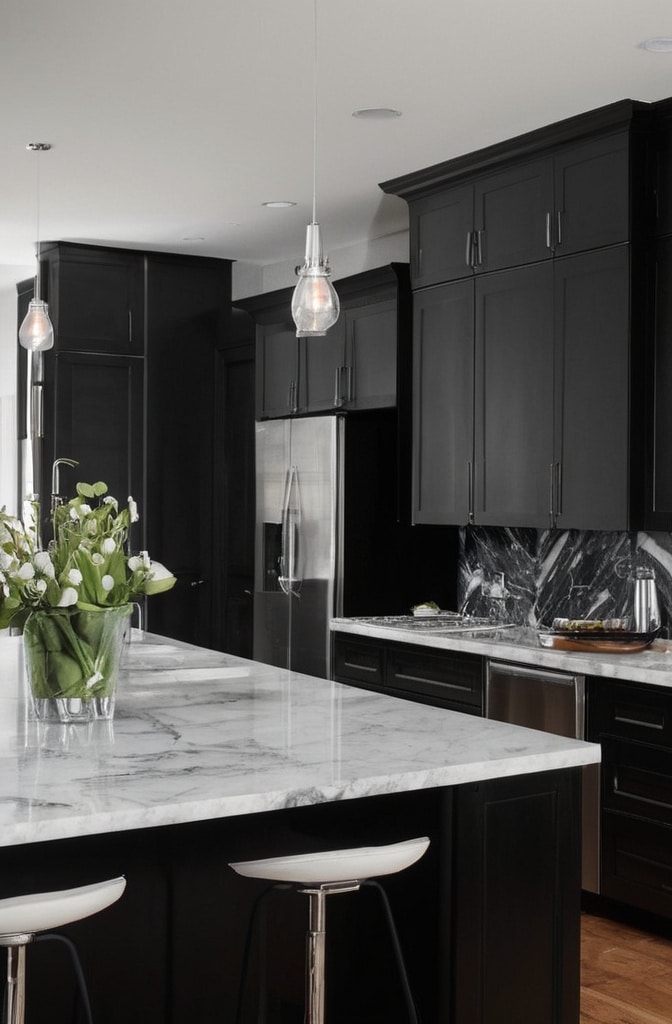
The practical aspects of maintaining a black and white kitchen deserve consideration during the planning phase, as each color presents unique challenges.
Cleaning Challenges Specific to Black and White Surfaces
- White surfaces show dirt, food stains, and grime more readily
- Black surfaces reveal dust, fingerprints, and water spots dramatically
- High-contrast edges (where black meets white) tend to collect visible grime
“Many clients are surprised that both black and white require regular maintenance, just for different reasons,” notes cleaning specialist Teresa Rodgers. “White shows what black hides and vice versa.”
For easier maintenance:
- Choose cabinet finishes with anti-fingerprint technology
- Select quartz countertops rather than more porous natural stone
- Opt for slightly textured surfaces rather than completely smooth ones
- Consider satin or matte finishes which show fewer water spots than high-gloss
Products Professionals Swear By
Professional house cleaners recommend these specific products for maintaining black and white kitchens:
- For white surfaces: Method All-Purpose Cleaner cuts grease without leaving residue
- For black surfaces: Weiman Glass Cleaner leaves a streak-free finish
- For natural stone: Granite Gold Daily Cleaner is non-abrasive and safe for food surfaces
- For stainless steel: Hope’s Perfect Stainless prevents fingerprints
“Microfiber cloths are essential for black surfaces,” advises professional cleaner Miguel Santos. “Traditional paper towels or cotton rags often leave visible lint or streaks that are particularly noticeable on dark surfaces.”
Conclusion
The enduring popularity of black and white kitchens stems from their remarkable ability to be simultaneously classic and contemporary. This versatile palette creates a foundation that can evolve with changing tastes while maintaining its sophisticated character.
